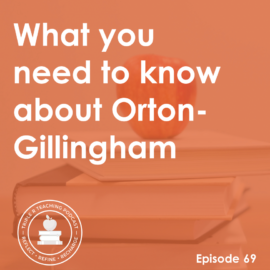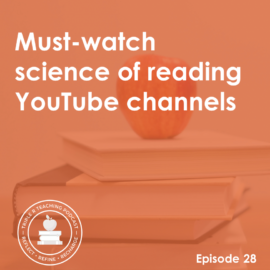
TRT Podcast#74: 6 strategies for reading multisyllable words
Do you have students who struggle to read longer words? These six strategies will give you the tools you need to help. #4 is my favorite!
Listen to the episode here
Full episode transcript
Hello, Anna Geiger here and welcome to the Triple R Teaching podcast, Episode 74. Today we're going to look at six strategies for teaching students to read multisyllable words.
The first strategy is one you're likely already doing, and that's to encourage your students to find the short words in longer words. This is really helpful particularly for beginning readers who are just starting to read longer words, words that might have an -ed or -ing ending. Have them find the chunk they know and then add the ending.
For example, in the word "playing," they would find the word "play" and then add the ending -ing.
This can also work with words with the consonant-le ending. For example, in the word "bottle," the child can read the "bot" at the beginning and then add the ending.
The next thing we should do is make sure that we introduce our students to common affixes - prefixes and suffixes - early on. So this should begin in about second grade, even earlier if students are ready for it. Interestingly, you don't need to teach a ton of prefixes and suffixes for this to help. A study in 1989 found that 58% of all words with prefixes were accounted for with the prefixes un-, re-, in-, and dis-. Among suffixes, the inflections on verbs, -ing and -ed, and nouns, -s and -es, accounted for more than 60% of word endings.
I'll include notes on this in the show notes, but the point is that you don't need to have a huge list of prefixes and suffixes to teach in order for it to make a big difference when your students tackle multisyllable words.
Our next strategy for teaching students to read multisyllable words is actually a little bit controversial in science of reading circles.
**What if you could get a solid understanding of the research without spending hours reading dry professional journals? What if you knew how to pinpoint each student's instructional needs and make a do-able plan for moving forward? What if you could find a solid system for teaching phonemic awareness, phonics, and vocabulary? What if you could be confident that your students had exactly what they need to grow in fluency and achieve the ultimate goal, strong reading comprehension? What if you had the resources you need to plan engaging whole class lessons and efficient, targeted small group instruction? What you want is within your reach and it's all within our online course, Teaching Every Reader. The doors open to the public on May 16th, 2022, mark your calendar and visit teachingeveryreader.com to learn more.**
The controversial technique is teaching students syllable division and syllable types. I think the reason that it gets so much flack from some people is that it can be time-consuming. Interestingly, in her book, Teaching Word Recognition, Rolanda O'Connor tells us that we actually don't have to spend a ton of time teaching these types of things to older, struggling readers. She often talks about how it only takes maybe a month or so of intervention in these particular strategies, perhaps only a total of five hours, and it can make a really big difference in students' reading. So just keep that in mind, as I talk to you about some of these things that we can consider.
Teaching syllable types means helping kids understand that there are six (or seven, depending on how you count) different types of syllables.
The closed syllable has a short vowel sound because it ends with a single consonant following that single short vowel. For example, the word "can" is a closed syllable. In the word "kitten," both syllables are closed. Now you might notice that in the second part of the word, "ten," doesn't actually say "ten." It says "tin." That's because it has the schwa in it, but that doesn't change the fact that that is a closed syllable.
Then we have open syllables that end with a long vowel. So the word "hi," as in, "Hi, how are you?" or "go." Those are open syllable words. Then we can put them into longer words like the word "robot." The first syllable "ro" is open. The second syllable "bot" is closed. Those are the two basic ones that I think we can teach to really young kids.
Then we go on to others like the magic E syllable, vowel team, diphthong (which is sometimes included with vowel team), bossy R, and consonant-le. Knowing the syllable types and having practice with them can really help kids as they solve multisyllable words.
Kind of alongside that are pretty intense, in my opinion, syllable division strategies, where you teach students how to examine a word, find the vowels, locate the consonants between, divide the word according to a pattern such as VC, CV, or V/CV or VC/V or V/V. Those are the four main ones.
It's quite a process to teach these to students, help them analyze the word by finding the consonants and vowels, dividing appropriately, labeling each syllable type, and then slowly sounding out the word. This is a very big part of many Orton Gillingham based reading programs.
I think there's value in this in helping students study and analyze words, but I think it is, in my opinion, a little unrealistic to think that when a child gets to a word they don't know they're going to actually label all the parts and divide it up. I just don't really see that happening. However, just this practice of analyzing long words can be useful.
My concern, as I mentioned in a previous episode, is that it takes a long time and I wouldn't want to see a ton of time spent on this each week, because really what we're really going for is practice with connected text. If we're going to spend fifteen minutes, multiple times a week, on syllable division, I just don't think that's a really useful use of our time. Now that's my opinion. I personally do believe that teaching syllable types is useful, but again, we've got to keep our end goal in mind here.
Our fourth strategy is from Rolanda E. O'Connor in Teaching Word Recognition, which is such a great book. I'm sure I've mentioned that before, but it's definitely worth purchasing. She has a technique called BEST. That's the acronym and it's good for elementary students.
To teach the strategy you present the acronym BEST and you help your students understand what each letter stands for. B stands for break off the word parts you know, so that could be breaking off a prefix or a suffix. E is for examine what's left and underline the vowels. Underlining the vowels can help you see where the syllables occur. S is for say each part, and T is try the whole thing in context.
In her book, she tells us that memorizing the acronym and the actions will take a few minutes the first day and less time as they get more practice with it. When you do the first step, breaking the word apart, that requires them to know prefixes and suffixes, so you want to make sure you've taught those and also identifying the base word within a longer word. Then as they underline those vowels in the rest of the word, that can help them chunk it out.
In her research, O'Connor found that kids with reading disabilities understood this after four or five days of instruction, with just five minutes each day, but it took about two weeks before they found the students challenging each other to BEST a long word they encountered in their reading. That's really cool to find out they actually applied this. I would say this is much easier to apply on the run than a long syllable division type strategy. She suggested that teachers should use this strategy with their students for a few minutes daily for at least three weeks before expecting it to make a difference.
Strategy number five is to have students use their understanding of basic phonics rules to decode longer words. One quick example, if a word has a double consonant in the middle, it usually means the vowel preceding it is short. So in the word "scrubbing," it wouldn't be "scroob-ing," it would be "scrubbing" because that double consonant alerts us to that. We know because when you have a word with a single short vowel and a final consonant, and you're adding -ing, the general rule is that you double that final consonant. That's just one example, but knowing these basic phonics rules can help students as they analyze parts of words.
Finally, the last strategy we're going to talk about today, our sixth and final one, is having a flexible syllable division strategy based on finding the vowels. I'm going to include a video in the show notes for this episode from Reading Rockets with Linda Farrell, I just love her. She has a video where she's working with a boy and she's helping him decode longer words by first finding the vowels, and then pulling down the chunks, the syllables of each word, using those vowels as a guide, and then reading those syllables and putting them together. It's flexible because we're not worried so much about syllable division rules. We're just mainly looking for vowels, dividing the word into syllables, which may not be a hundred percent correct, but it will probably be good enough for reading the word.
This strategy is flexible. It's definitely not as exact as the syllable division strategies I mentioned earlier, and it's certainly up for debate as to which is better, but I think it's good to have all of these up your sleeve.
Today in the show notes, I'm going to make sure to give you a PDF that lists all of these strategies. You can have them at your fingertips as a reference when you're helping your students learn to decode multisyllable words. You can find that at themeasuredmom.com/episode74. Thanks for listening. I'll talk to you again next week!
Sign up to receive email updates
Enter your name and email address below and I'll send you periodic updates about the podcast.

Get this free cheat sheet!
Related resources
- Teaching Word Recognition, by Rollanda E. O’Connor
- Six Syllable Types – Reading Rockets
- Reading Multisyllable Words video with Linda Farrell and Xavier (third grader)







Leave a Comment